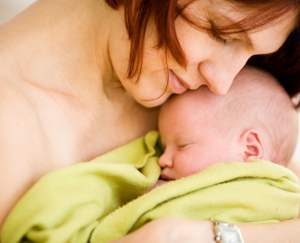Penn Herb Wellness Guide
5 Great Ways to Green Your Baby

Pay attention
The first step toward that goal, says Christopher Gavigan, CEO and executive director of Healthy Child Healthy World (HCHW), is awareness. “The products we use in our home, the foods we buy, the toys our children play with, all can affect the health of our family.” One of HCHW’s missions is to offer simple, practical, science-based steps that anyone can use to create a greener home environment. “No parent can do everything,” Gavigan points out, “but every parent can do something.”
Clean green
When baby-proofing your home, think beyond plugging outlets and putting up safety gates. By switching to nontoxic, environmentally friendly household cleaners—look for phosphate-free, petroleum-free, and fragrance-free—you can keep the air, floor, tub, and furniture clear of harsh chemicals. And since children are especially vulnerable to pesticides and likely to put anything they get their hands on into their mouths, including grass, practice natural pest control in your home and yard.
Shop organic
This is top of Gavigan’s list of positive changes. If you can’t go completely organic, start with dairy and meats and the fruits and vegetables that typically have the highest pesticide residue. Further limit your baby’s exposure to toxins by choosing clothing, linen, blankets, and even a nursery rug and crib mattress made from organic, naturally dyed fabrics. Bathe, shampoo, and lather your little one with organic soap, shampoo, and lotion. Opt for non-VOC (volatile organic compound) paint and furniture. Look for toys and books made from untreated wood, paper, organic fabric or metal, materials that are nontoxic and safe for a baby to chew on.
Pick plastics wisely
Many baby bottles, rattles, and bath toys are made from plastic. Whenever possible opt for glass, nonleaded ceramic, wooden or stainless steel alternatives. The most eco- and baby-friendly are bioplastics, which are made from corn and other substances. To identify a plastic, look at the number inside the recycling symbol. Bioplastics will be labeled as such.
The catchall category, #7, includes less desirable plastics. Better choices are polyethylene (#1, #2, and #4) and polypropylene (#5), which are nonchlorinated and use fewer toxic additives than other plastics.Avoid PVC (polyvinyl chloride)—identified with a “V” or #3—or polystyrene (#6), which can leach chemicals. Regardless of the type, plastic products should not be used in the microwave or dishwasher, since heat can cause chemical breakdown.
Watch the bottom line
The typical child goes through 8,000 diapers before she’s toilet trained. In the United States that translates to 49 million diapers disposed each day. Most of those end up in landfills, where they will remain for the next 200 to 500 years before they decompose. Want ecofriendlier options?
Start by choosing diapers that are chlorine-free and perfume-free. Try dual-layer “hybrid” diapers that have a washable, reusable outer layer, and a liner that is absorbent, disposable, and biodegradable. In fact, some liners can be safely flushed down the toilet.
Cloth diapers have had a makeover of late. Many come with snaps, fitted waist and legs, and can be used with liners. If you do go disposable, look for the new, ecofriendly options. By taking a few steps toward a greener environment you can have a positive impact on your baby’s health as you limit your impact on the planet your children and their children will inherit.
Christopher Gavigan’s book, Healthy Child Healthy World, Creating a Cleaner, Greener, Safer Home, is filled with tips on how to do just that. For more information, log onto www.healthychild.org
Copyright 2025 TraceGains, Inc. All rights reserved.


